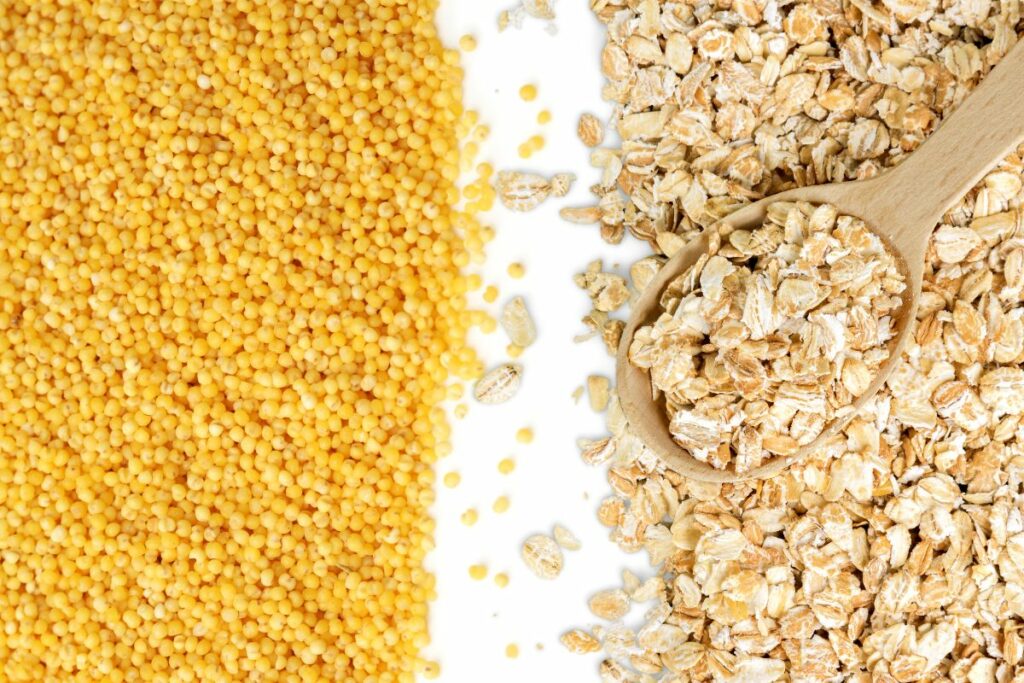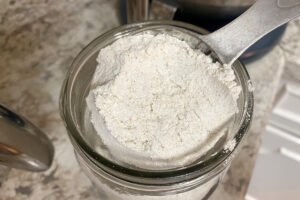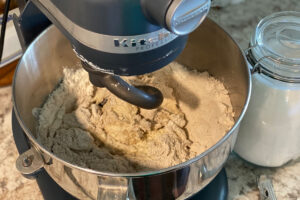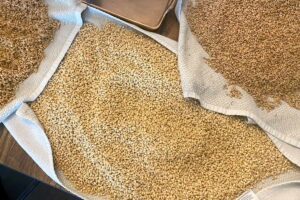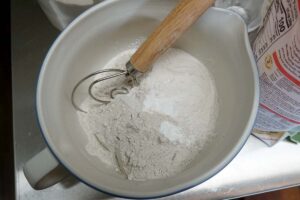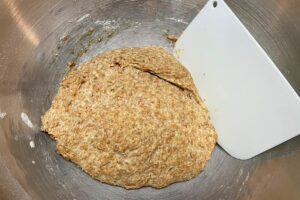You probably grew up eating oatmeal (typically instant oatmeal) but for most Americans, Millet is new, although it’s been enjoyed by cultures around the world for thousands of years.
What’s the difference between millet and oats? Can they be used interchangeably? Should you stop eating oats and instead opt for millet? As with any whole grain we didn’t grow up cooking and eating, all of this can be a bit overwhelming.
If you are trying to figure out which grain is right for your dietary needs, understanding the nutritional facts and comparison between millet and oats is essential. It will empower you to make the best choice for you and your family.
In this article, we’ll take a closer look at these ancient superfoods to understand their nutrition facts and compare them to each other.
Let’s go.
What is Millet?
Millet is a small, round grain that is often referred to as a pseudo-grain, which means it not technically a grain, although it’s referred to a grain because it is consumed like one (confusing, right? Check out this article to better understand grains and pseudo-grains). It has been cultivated for thousands of years and is still used today in many parts of the world.
Millet facts
- Ancient grain: Millet has been cultivated for over 10,000 years, making it one of the oldest known foods for humans. It has been a staple in diets across Asia and Africa for millennia
- Diverse varieties: There are several types of millet, including pearl, finger, proso, and foxtail millet. Each variety has its unique taste, texture, and nutritional profile
- Gluten-free: Millet is naturally gluten-free, making it a great grain choice for those with celiac disease or gluten sensitivities
- Drought resistant: Millet is known for its ability to grow in arid conditions and poor soil quality. It requires very little water compared to other grains, making it an essential crop in regions prone to drought.
- Nutritional powerhouse: Millet is rich in essential nutrients like magnesium, phosphorus, iron, and B-vitamins. It’s also a good source of protein and dietary fiber.
- Low Glycemic Index (GI): Millet has a relatively low glycemic index, which means it releases sugar slowly into the bloodstream, helping to maintain steady blood sugar levels
- Traditional uses: In many cultures, millet is used in traditional dishes. For instance, in India, it’s used to make roti (a type of flatbread), and in Africa, it’s used in porridges and beers
- Birdseed and beyond: While millet is commonly known in Western countries as a primary ingredient in birdseed, it’s a staple food for many people around the world
- Beneficial for digestion: The fiber content in millet can aid digestion and prevent constipation. It also promotes a healthy gut microbiome
- Alkaline Nature: Millet is alkaline, which means it’s easy on the stomach and can help balance the body’s natural pH levels (more on alkaline grains here)
- Culinary versatility: Millet can be used in a variety of dishes, from breakfast porridges to salads, soups, and desserts. It can also be popped like popcorn!
- Cultural significance: In many cultures, millet holds cultural and religious significance. For example, in India, millet is used in various festivals and rituals
- Sustainable crop: Due to its low water requirements and ability to grow in less fertile soils, millet is considered a sustainable crop that can play a role in addressing food security issues in the face of climate change.
What are the benefits of Millet?
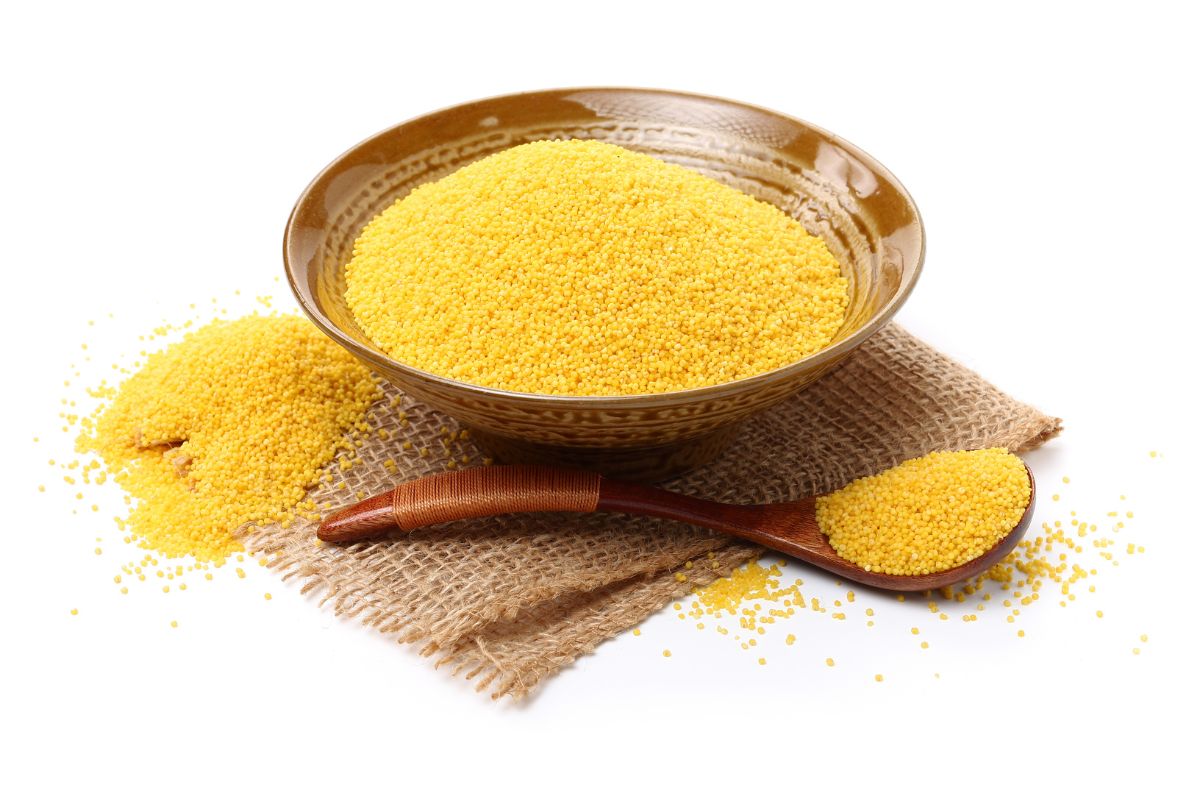
Antioxidant levels are rich
Millets are a type of cereal grain that is rich in antioxidants, which can help protect the body from oxidative stress.
Can aid in controlling blood sugar levels
Millets are a great choice for people with diabetes as they can help control blood sugar levels.
Additionally, millets have a low glycemic index, meaning that they won’t cause sudden spikes in blood sugar levels.
What are Oats?
Oats are a nutritious food that can provide many health benefits when consumed regularly. When we think of “oats” we often think of instant oats that we buy from the grocery store, but it’s important we understand that these are highly-processed and lack a lot of the nutrients of whole oat groats.
And there are even more types of oats:
- Whole oat groats: Whole oat kernels with only the inedible outer husk removed. They are the least processed form of oats
- Steel-cut oats (also known as “Irish” or “Scottish Oats”): Whole oat groats that have been chopped into pieces using large steel blades.
- Rolled oats (also known as “Old-fashioned oats”): Whole oat groats that have been steamed and then rolled into flakes
- Quick or instant oats: Rolled oats that have been cut into smaller pieces and then pre-cooked by steaming
- Oat flour: Made by grinding oats into a fine powder
- Oat bran: The outer layer of the oat groat and is packed with fiber
When we talk about “oats” we’re talking about “whole oat groats.” You can see a side-by-side comparison of the nutritional values of all these different oats here, where we talk about the digestibility time of oats.
Oat facts
- Ancient origins: Oats have been consumed by humans for thousands of years. They were a staple in the diets of many ancient civilizations, including the Greeks and Romans. This is why it doesn’t make sense when people talk about oats being unhealthy … it’s the processed “instant oats” that are unhealthy, not whole oat groats!
- Heart health: Oats are renowned for their heart-healthy properties. They contain beta-glucans, a type of soluble fiber that can help lower cholesterol levels
- Gluten controversy: While oats are naturally gluten-free, they are often processed in facilities that handle gluten-containing grains, leading to cross-contamination. It’s essential to look for certified gluten-free oats if you have celiac disease or gluten sensitivity
- Rich in nutrients: Oats are a good source of essential nutrients, including magnesium, iron, zinc, and B-vitamins. They also provide a decent amount of protein
- Low Glycemic Index (GI): Oats have a low glycemic index, which means they release sugar slowly into the bloodstream, helping to maintain steady blood sugar levels
- Skin benefits: Oats have been used for centuries in skincare. They have anti-inflammatory properties and can be used in baths to soothe skin conditions like eczema and rashes. It’s why your great grandma probably had “oatmeal baths” a part of her arsenal of home treatments
- Versatile in cooking: Oats can be used in a variety of dishes, from breakfast porridges and granolas to savory dishes, baked goods, and even beverages like oat milk
- Sustainable crop: Oats are a sustainable crop that can be grown in various climates. They also act as a natural weed suppressant and can improve soil health
- Avenanthramides: Oats contain unique antioxidants called avenanthramides, which have anti-inflammatory and anti-itching properties
- Traditional medicine: In traditional medicine, oats were used as a tonic to boost stamina and improve overall health.\
- Oat Straw: The green, unripe parts of the oat plant, known as oat straw, are used in herbal medicine to support mental health and cognitive function
- World Production: Russia, Canada, and Poland are among the top oat-producing countries in the world.
- Horse Feed: While oats are a staple in many human diets, they are also commonly used as feed for horses due to their high nutritional value
What are the benefits of Oats?
They’re nutritious
Oats are incredibly nutritious and a great addition to any diet. They are a well-balanced source of carbs and fiber, providing fiber which is beneficial for digestion and heart health.
Oats also contain high-quality protein with a good balance of essential amino acids, making them an excellent choice for vegetarians or vegans looking to increase their protein intake.
Can help lower cholesterol levels
Eating oats regularly is an easy way to reduce your risk for heart disease by lowering your cholesterol levels.
Oats are a versatile food that can be eaten as oatmeal or added to other dishes like smoothies or baked goods.
They are also relatively inexpensive and widely available, making them an accessible option for people looking to improve their health.
What are the nutritional differences between Millet and Oats?
Millet and oats are both nutritious grains that can be used in a variety of recipes. They are inherently different and are best used for different applications.
I want to show you a side by side comparison to help you better understand these differences. Below are the approximate averages for a 1/2 cup cooked serving and can vary based on specific brands, processing methods, and preparation.
| Whole oat groats | Millet | |
|---|---|---|
| Calories | 150 | 207 |
| Carbohydrates | 27g | 41g |
| Protein | 7g | 6g |
| Dietary Fiber | 7g | 2.2g |
| Total Fat | 2.5g | 1.7g |
| Saturated Fat | 0.5g | 0.3g |
| Monounsaturated Fat | 1g | 0.3g |
| Polyunsaturated Fat | 1g | 0.5g |
| Vitamin B6 | 0.2mg | 0.4mg |
| Folate | 20μg | 85μg |
| Iron | 2mg | 1.7mg |
| Magnesium | 60mg | 73mg |
| Phosphorus | 180mg | 162mg |
| Potassium | 150mg | 195mg |
| Zinc | 2mg | 1.7mg |
While they have many similarities, there are also some key differences between the two when it comes to their nutritional content.
Differences to point out:
- Millet contains more protein, calcium, magnesium, phosphorus, potassium, zinc, and iron than oats. It also has a higher amount of dietary fiber than oats
- Oats contain more thiamin, riboflavin, niacin, and folate, which are all types of vitamin B.
- In terms of calories, millet contains slightly more than oats per serving
Similarities to point out:
- Both grains are good sources of complex carbohydrates, which provide sustained energy throughout the day
- Both are gluten-free, which makes them suitable for people with celiac disease or gluten sensitivity
Which grain is better: oats or millet?
“Healthy” and “nutrition” are such a personal preference. I wanted to provide you with a side-by-side chart to help you think through which one may be best for you and your family:
| Factor | Oats | Millet |
|---|---|---|
| Gluten content | Naturally gluten-free but may be cross-contaminated during processing. Choose certified gluten-free if needed | Naturally gluten-free |
| Nutritional profile | Rich in soluble fiber (beta-glucans), magnesium, iron, zinc, and B-vitamins | Good source of magnesium, phosphorus, iron, B-vitamins, and antioxidants |
| Glycemic Index | Low glycemic index (GI), releasing sugar slowly into the bloodstream | Relatively low glycemic index (GI) |
| Digestibility | Soluble fiber aids digestion and promotes gut health | Easy to digest and alkaline, balancing the body’s pH levels |
| Versatility in cooking | Common in breakfast dishes like oatmeal, savory dishes, and as a binding agent | Used in hot cereals, salads, side dishes, and desserts |
| Environmental impact | Grown in various climates, considered a sustainable crop | Drought-resistant, requires little water, environmentally friendly in arid regions |
| Taste and texture | Mild, slightly sweet taste with a creamy texture when cooked | Nutty flavor with a slightly crunchy texture |
Remember: Both grains have their unique benefits, and the choice between them often depends on YOUR individual preferences and dietary needs.
The best way to figure out what you like is to try different Oat Recipes and Millet Recipes and see which you prefer!
Substituting Millet and Oats for each other: 15 recipe ideas
What makes both Millet and Oats a good pair is that they can be easily subsituted for each other in recipes. So no matter if you’re on “Team Millet” or “Team Oats,” you can use them fairly interchangeably.
Here are some versatile recipe ideas that can use either millet or oats:
- Breakfast hot cereals: Cook the grains in milk (dairy or plant-based) until soft. Top with fresh fruits, nuts, seeds, and a drizzle of honey or maple syrup
- Grain salad: Cook the grains and let them cool. Mix with chopped vegetables, feta cheese, and a tangy vinaigrette. Great for a refreshing lunch!
- Granola bars: Combine roasted grains with nuts, seeds, dried fruits, and a binder like honey or maple syrup. Press into a pan, bake, and then cut into bars
- Pancakes: Grind the grains into a flour and use them as a base for pancakes. Add eggs, milk, and your choice of sweeteners and flavorings
- Muffins and breads: Use ground grains as a primary or supplementary flour in muffins, bread, or other baked goods
- Stuffed vegetables: Cook the grains with herbs and spices, and use them as a stuffing for bell peppers, tomatoes, or zucchini
- Energy bites: Mix ground grains with nut butter, honey, dried fruits, and chocolate chips. Roll into balls and refrigerate
- Grain bowls: Top cooked grains with roasted vegetables, a protein source (like tofu, chicken, or beans), and a flavorful sauce or dressing
- Casseroles: Use the grains as a base layer, add a protein source, vegetables, and a sauce or broth. Bake until everything is cooked through
- Puddings: Cook the grains in a mixture of milk and sweetener until they have a creamy consistency. Flavor with vanilla, cocoa, or spices
- Smoothies: Add cooked grains to your favorite smoothie recipe for added texture and nutrition
- Cookies: Grind the grains and use them in place of traditional flours in cookie recipes
- Veggie Burgers: Mix cooked grains with mashed beans or lentils, vegetables, and spices. Shape into patties and pan-fry or bake
- Overnight “Oats”: Mix raw grains with yogurt and milk, and let them soak overnight. In the morning, they’ll be soft and ready to eat, topped with your favorite additions
- Soups and stews: Add the grains to soups and stews for added texture and nutrition
Remember, when substituting millet for oats or vice versa, you may need to adjust the cooking time and liquid ratios, as the two grains have different textures and cooking requirements.
Frequently asked questions
Are millet and oats the same thing?
No, millet and oats are not the same thing. While both are grains, they come from different plant families. Oats are cereal grains derived from the Avena sativa plant, while millet refers to a group of small-seeded grasses that are widely grown around the world, especially in Asia and Africa. The texture, flavor, and nutritional profiles of the two grains are also distinct.
Can you substitute millet for oats? Or, oats for millet?
Yes, millet can be substituted for oats and vice versa in many recipes, but the texture and flavor will differ. For instance, if you’re making a hot cereal, millet will give a slightly nuttier flavor and a different texture compared to oats.
When substituting, it’s essential to adjust the cooking time and liquid ratios as millet might require more or less water and cooking time than oats, depending on the preparation. It’s always a good idea to start with a small batch to determine the right adjustments.
Is millet the healthiest grain?
Millet is undoubtedly a nutritious grain, rich in fiber, vitamins, and minerals. It is gluten-free, making it a suitable choice for those with gluten sensitivities or celiac disease. Millet also has a low glycemic index, which can be beneficial for blood sugar control.
However, labeling it as the “healthiest” grain might be subjective as different grains offer various health benefits. For instance, Quinoa is rich in protein, while oats are known for their heart-healthy properties. The best approach is to include a variety of grains in your diet to benefit from the unique nutrients each one offers.
What grains are healthier than oatmeal?
The term “healthier” can be subjective and depends on individual dietary needs and health goals. Oatmeal made from whole oat groats (more on why instant oatmeal is not healthy is here) is renowned for its heart-healthy properties, especially its ability to lower cholesterol. However, other grains also offer significant health benefits:
- Quinoa: High in protein and contains all nine essential amino acids
- Barley: Known for its fiber content, especially beta-glucans, which can help lower cholesterol
- Buckwheat: Rich in antioxidants and can help improve blood sugar control
- Teff: High in protein, calcium, and iron
- Amaranth: A good source of protein and lysine, an essential amino acid often lacking in grains
While each grain has its unique set of benefits, it’s essential to choose grains that align with your health goals and dietary preferences.

